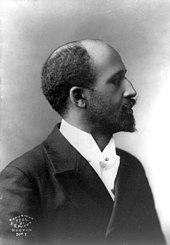Minstrel Show
Minstrel Show or blackface minstrelsy (named after a blackface designated black-painted face of the clown ) is a minstrel , in which White in the form of stereotypes represent blacks. The most famous example was Thomas D. Rice , who appeared as Jim Crow with a black face. The Blackface Minstrelsy was very popular in the north of the United States between 1840 and 1870, especially among industrial workers.
Minstrel shows showed the whites, who often did not know blacks from their everyday lives, numerous stereotypes of blacks in a stylized form. They are portrayed as constantly happy, singing and naive slaves who love their owners despite their hard work. A romanticizing idea of the everyday life of the slaves on the plantations is staged. Many stereotypes found their way into other national narratives and songs. My Old Kentucky Home by Stephen Foster and Dixie were particularly popular .
After Thomas Rice's death, black people were hired for the show by the traveling minstrels from 1860 onwards. Some jazz and blues musicians like Jelly Roll Morton , WC Handy , Ma Rainey and Bessie Smith financed the beginning of their careers by appearing in minstrel shows.
Socio-historical explanations

David Roediger's psychoanalytic explanation of the Blackface Minstrelsy is based on Du Bois' thesis that whiteness represents a “gain” for white North American industrial workers over black workers . According to DuBois, the white workers were “shown public respect ... because they were white. They had free access to public events and parks, along with whites of other classes ... The police were recruited from their ranks ... Public officials were appointed through their votes, which had little effect on their economic situation, but a lot on their treatment by the authorities ... ". According to Roediger, industrial workers in the north of the USA were subject to intense discipline and control. The resulting anger, however, was not directed at the cause of their misery , but mainly through the blackface minstrelsy on the blacks. In the Blackface Minstrelsy, psychologically speaking, the white workers were playing their lost, unbridled selves. In this way they could "show off their natural selves and reject them at the same time" (Roediger). Like DuBois, Roediger describes the enjoyment of this game as the “gain” of white workers for their whiteness. Through the demarcation from the blacks in the blackface minstrelsy, whiteness was thus constructed.
In contrast to Roediger, Alexander Saxton sees the blackface Minstrelsy, which he attributes to the same attitude that led to the lynching of blacks during the riots in New York in 1863 , as a form of class politics : “Through its stylized form, it metaphorically propagated an alliance between the urban workers and the interests of the plantation owners in the southern states. ”The white workers naively reproduced the perspective of the white slave owner . Blackface Minstrelsy therefore serves the purposes of the Democratic Party and at the same time conceals the contradiction between the rich southern states - aristocrats and the "fighting workers in the north". Andrew Hartman describes Roediger's thesis as follows: "Thus Blackface Minstrelsy was more than just a psychological gain for Saxton, but rather the mass-cultural equivalent of the white egalitarianism of the Jackson Democrats."
Feature films that feature Minstrel Show
- Babes on Broadway (1941), a musicalstarring Mickey Rooney and Judy Garland .
- The Jazz Singer (1927), based on a piece by Samson Raphaelson .
- My Wild Irish Rose (1947), starring Dennis Morgan , Andrea King and Arlene Dahl .
- Show Boat (1936), with Irene Dunne , Allan Jones, Hattie McDaniel, and Paul Robeson .
- Bamboozled (2000), a satirical film directed by Spike Lee .
- Masked and Anonymous (2003), a film set in a dystopian future. Ed Harris plays a performer who uses blackface.
literature
- William E. Bhurghard Du Bois : Black Reconstruction. An Essay toward a History of the Part which Black Folk played in the Attempt to Reconstruct Democracy in America, 1860-1880. Harcourt-Brace, New York NY 1935.
- Minstrel Show. In: Richard Moody (Ed.): Dramas from the American Theater. 1762-1909 (= New World Literature Series. Vol. 1, ZDB -ID 2384813-3 ). Houghton Mifflin, New York NY et al. 1969.
- Alexander Saxton: The Rise and Fall of the White Republic. Class Politics and Mass Culture in Nineteenth Century America. Verso, London et al. 1990, ISBN 0-86091-271-X .
- David R. Roediger: The Wages of Whiteness. Race and the Making of the American Working Class. Verso, London et al. 1991, ISBN 0-86091-334-1 .
- Noel Ignatiev : How the Irish Became White. Routledge, New York NY et al. 1995, ISBN 0-415-91384-5 .
- Nick Tosches: Where Dead Voices Gather. Little, Brown and Company, Boston MA et al. 2001, ISBN 0-316-89507-5 .
- Joshua Kwesi Aikins: Who plays with fire ... Appropriation and resistance - Black music / cultures in Germany's white mainstream. In: Maureen Maisha Eggers, Grada Kilomba , Peggy Piesche, Susan Arndt (eds.): Myths, masks and subjects. Critical whiteness research in Germany. Unrast, Münster 2005, ISBN 3-89771-440-X , pp. 283-300.
- Andrew Hartman: Races and Classes. The rise and fall of whiteness studies in the United States. In: iz3w . No. 292, 2006, pp. 40-44.
- Marc Bauch : "Gentlemen, Be Seated!" The Rise and Fall of the Minstrel Show. GRIN-Verlag, Munich 2011, ISBN 978-3-656-08636-9 .
- Melisa M. Zapata-Rodríguez: Minstresy: Iconography of Resistance During the American Civil War . In: Music in Art: International Journal for Music Iconography . 41, No. 1-2, 2016, ISSN 1522-7464 , pp. 111-127.
swell
- ↑ a b c d Andrew Hartman: Races and Classes. The rise and fall of whiteness studies in the United States. In: iz3w. No. 292, 2006, pp. 40-44. Compare Joshua Kwesi Aikins: Who plays with fire ... Appropriation and resistance - Black music / cultures in Germany's white mainstream. In: Maureen Maisha Eggers, Grada Kilomba, Peggy Piesche, Susan Arndt (eds.): Myths, masks and subjects. Critical whiteness research in Germany. 2005, pp. 283-300.
